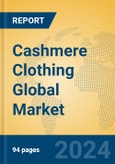Market Size and Growth Forecast
The global Cashmere Clothing market is projected to reach USD 3.3 billion to USD 3.5 billion in 2025, with a CAGR of 1% to 2% through 2030, expanding to USD 3.5 billion to USD 3.8 billion, reflecting modest luxury growth.Regional Analysis
- North America: Expected at 1% to 2%, the U.S. holds 25%-30% share. Trends focus on luxury retail.
- Asia Pacific: Forecasted at 1% to 3%, China and Japan hold 25%-35%. Trends emphasize production scale.
- Europe: Projected at 0% to 2%, Italy and France hold 35%-40%. Trends favor premium brands.
- Middle East and Africa: Anticipated at 0% to 1%, holds 1%-2%. Trends lean toward niche markets.
- South America: Expected at 0% to 1%, holds 1%-2%. Trends focus on emerging luxury.
Application Analysis
- Men: Projected at 1% to 2%, holds 40%-45%. Trends shift to tailored fashion.
- Women: Expected at 1% to 2%, holds 35%-40%. Trends favor versatility.
- Children: Forecasted at 0% to 1%, holds 15%-20%. Trends emphasize comfort.
Product Type Analysis
- Sweaters and Coats: Projected at 1% to 2%, holds 55%-60%. Trends focus on classic styles.
- Bottom Wear: Expected at 0% to 1%, holds 20%-25%. Trends favor casual luxury.
- Shirts & T-shirts: Forecasted at 1% to 2%, holds 10%-15%. Trends emphasize innovation.
Key Market Players
- Erdos Group: A Chinese leader, Erdos dominates cashmere.
- Ermenegildo Zegna: An Italian giant, Zegna excels in luxury.
- Loro Piana: An Italian firm, Loro Piana prioritizes quality.
- Brunello Cucinelli: An Italian player, Cucinelli targets premium.
- Kingdeer: A Chinese entity, Kingdeer boosts supply.
- Beijing Snow Lotus: A Chinese firm, Snow Lotus serves fashion.
- Huzhou Zhenbei: A Chinese innovator, Zhenbei refines products.
- Gobi: A Mongolian leader, Gobi focuses on authenticity.
- Cashmere Holding: A global player, Cashmere diversifies offerings.
- Malo: An Italian firm, Malo emphasizes craftsmanship.
- Pipigou: A Chinese entity, Pipigou targets scale.
- Zhejiang Mihuang: A Chinese firm, Mihuang serves luxury.
Porter’s Five Forces Analysis
- Threat of New Entrants: Low, with supply and brand barriers.
- Threat of Substitutes: Moderate, as wool competes in price.
- Bargaining Power of Buyers: High, with affluent consumers seeking quality.
- Bargaining Power of Suppliers: High, due to concentrated cashmere sources.
- Competitive Rivalry: Intense, driven by brand prestige and scale.
- Impact of Tariff Conflicts on Supply Chain Localization
Market Opportunities and Challenges
Opportunities:
- Luxury Demand: Affluent consumers drive sales.
- Sustainability: Eco-friendly cashmere gains traction.
- China’s Role: Production dominance offers scale.
- Fashion Trends: Innovation boosts appeal.
- Emerging Markets: Asia Pacific drives growth.
Challenges:
- Supply Limits: Cashmere scarcity constrains output.
- Regulation: Environmental rules raise costs.
- Substitutes: Cheaper fibers threaten share.
- Economic Flux: Luxury spending may slow.
- Trade Risks: Tariffs disrupt export flows.
This product will be delivered within 1-3 business days.
Table of Contents
Companies Mentioned
- Erdos Group
- Ermenegildo Zegna
- Loro Piana
- Brunello Cucinelli
- Kingdeer
- Beijing Snow Lotus
- Huzhou Zhenbei
- Gobi
- Cashmere Holding
- Malo
- Pipigou
- Zhejiang Mihuang








